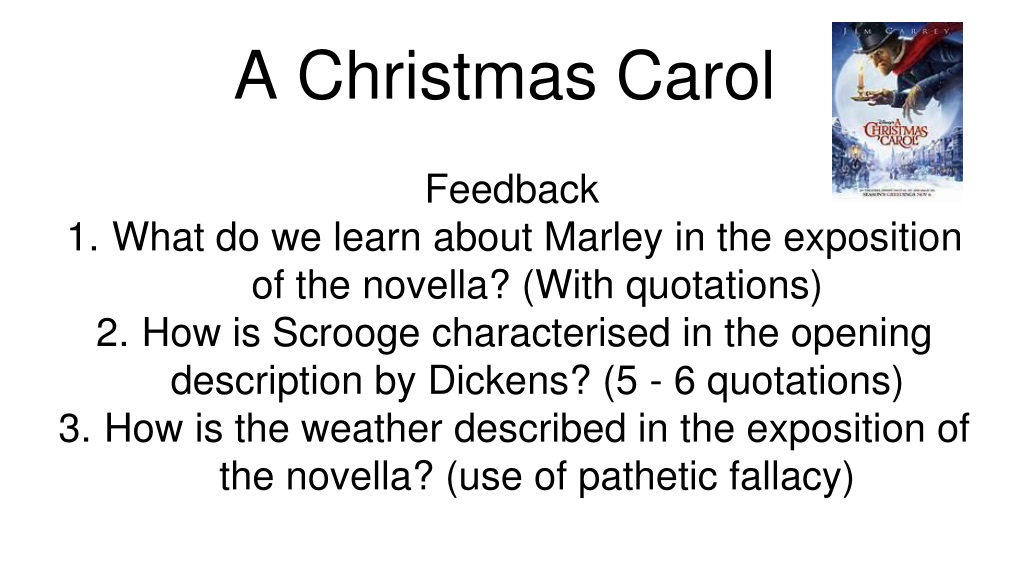

Replay
0 likes | 33 Views
In the exposition of "A Christmas Carol," Dickens introduces the character of Marley, emphasizing his death but hinting at supernatural returns. Scrooge is portrayed as miserly and unkind, with vivid descriptions highlighting his cold nature. The use of pathetic fallacy sets the eerie tone, reflecting Scrooge's inner frostiness. The theme of the supernatural is subtly introduced through the ghostly appearance of Marley, adding a chilling layer to the story.

E N D
A Christmas Carol Feedback 1. What do we learn about Marley in the exposition of the novella? (With quotations) 2. How is Scrooge characterised in the opening description by Dickens? (5 - 6 quotations) 3. How is the weather described in the exposition of the novella? (use of pathetic fallacy)
A Christmas Carol Feedback 1. ‘Marley was dead: to begin with.’ ‘Dead as a doornail.’ During the exposition of the novella ‘A Christmas Carol’ Dickens uses the repetition of the death of Marley to exemplify in no uncertain terms that ‘Marley was dead:’ indicating that he has passed on and is no longer alive, something that seems final and an unarguable fact. However, the extract clause ‘:to begin with.’ highlights a level of uncertainty because it seems to foreshadow that he will not always be dead, in fact it suggests that he will come back to life, probably in the form of a ghost or supernatural entity. Dickens is using the juxtaposition of certainty and ambiguity to introduce the doubt in the reader's’ mind about whether Marley really has died. The simile ‘Dead as a doornail.’ further reiterates the incontrovertible nature of him being dead. However, Dickens may be using this introductory repetition to intrigue the reader as ghost stories and the use of gothic conventions was popular within the Victorian era and listening to a good story would have been a form of entertainment, something that Dickens could have been capitalising on through his allegory, in order to use entertainment to ensure that the wealthy could see the hypocrisy in their behaviour towards the poor during the Industrial Revolution, which was notoriously a terrible time for those with limited finances.
A Christmas Carol Feedback Characterisation: Miserable, miserly, avarice, greedy, unkind, unfriendly, unlikeable, uncharitable, isolated ‘Scrooge never painted out old Marley’s name’ ‘Tight fisted hand at the grindstone’ ‘A squeezing, wrenching, grasping, scraping, clutching, covetous old sinner!’ ‘Hard and sharp as flint’ ‘As solitary as an oyster’ ‘A frosty rime was on his head’ ‘Nobody ever stopped him in the street’
A Christmas Carol Feedback Pathetic Fallacy ‘The cold within him froze his old features’ ‘External heat and cold had little influence on Scrooge’ ‘Didn’t thaw one degree at Christmas’ ‘It was cold, bleak, biting weather: foggy withal’ ‘brown air’ ‘dingy cloud’
Scrooge’s behaviour in the counting house Keeps a close eye on the heating Doesn’t celebrate Christmas Refuses to recognise Fred’s kind invitation Rejects Fred Doesn’t want Bob to have Christmas Day off He raps a ruler at a Christmas Carol singer Has dismal conditions for his clerk
Fred - What he is like and what he does? Friendly, handsome, jolly, kind. Extends a Christmas invitation Is nice to Scrooge despite his miserly demeanour He refuses to be rude back to Scrooge He questions Scrooge’s behaviour He remains cheerful and wishes him a Merry Christmas and a Happy New Year - seasons greetings Shows Christian values and behaviour
The Clerk: Bob Cratchit Working conditions are harsh and cold ‘dismal little cell’ small fire - one coal’ ‘warm himself on a candle’ Resents paying him for Christmas day and giving him the day off Threatens to sack him for laughing Thinks he overpays him and that Bob is ungrateful for his situation
The Portly Gentleman: Symbolise benevolence Ask for help Fat - implies well fed Discuss the prisons and workhouses but indicate they believe these are failing the poor
The door knocker as Marley Supernatural apparition Scrooge shrugs it off His appearance is ghostly Lurid colour (bright) Light shining in the darkness and gloom At Scrooge’s house Could foreshadow a supernatural visitation
How does Dickens introduce the theme of the supernatural in A Christmas Carol? Dickens introduces the theme of the supernatural through Marley’s ghost appearing in the door knocker of Scrooge’s house. The supernatural apparition ‘not a knocker - but Marley’s face.’ is repeated to show that it really is happening and this is what Scrooge is experiencing, even though he shrugs it off and disbelieves his own eyes. The further repetition of the adjective ‘ghostly’ in ‘ghostly spectacles’ and ‘ghostly forehead’ reinforce the idea that this in a non- living entity that has purposely chosen to appear in Scrooge’s doorway as he is preparing to go home for the evening. The darkness and vivid description of the isolation of Scrooge’s house in ‘playing hide and seek with other houses, and forgotten it’s way out again’ metaphorically reinforces how remote and removed from society the house is, linking to Scrooge’s own literal isolation from society through his own choices. The supernatural appearance of Marley is also described as ‘horrible’ due to it being ‘perfectly motionless’ with the adverbial phrase suggesting the ghost doesn’t move or change in anyway, implying it could be a figment of Scrooge’s imagination. However, the way that the omniscient narrator reinforces the description of Scrooge’s expectation of seeing ‘Marley’s pigtail’ indicates that he really had this vision and despite the way he ignores and rejects it, it is in fact happening. The reader might feel disconcerted as earlier we had learned that ‘Marley was dead’ although the foreshadowing could stop us feeling completely unsettled as we were expecting a visitation from Marley as he was only dead ‘to begin with’. Dickens emphasises the spooky and eeriness of seeing a ghost to scare his Victorian audience and thrill them as the story would have held great entertainment value and the supernatural apparition of Marley would have been a vivid and fearful reflection that the dead are or could be watching over you. Marley is non-threatening as a ghost and the reader might wonder what his message is because at this point Marley has said nothing and Scrooge in his usual gruff manner has completely rejected the thought that Marley might be there for a reason. The ‘Pooh, pooh!’ sound that Scrooge makes reiterates his matter of fact nature and his inability to be phased by any aspect of human life that would frighten anyone else. It perhaps reflects his complete removal and isolation from society as he seems incapable of real, true and human emotions. A ghost is not something to ignore, but Scrooge chooses this course of action implying he is callous and lacking in emotion.
